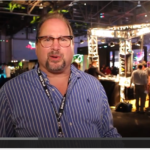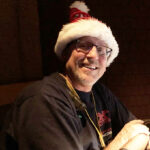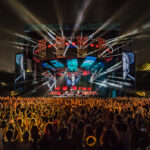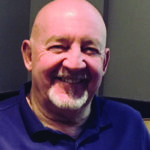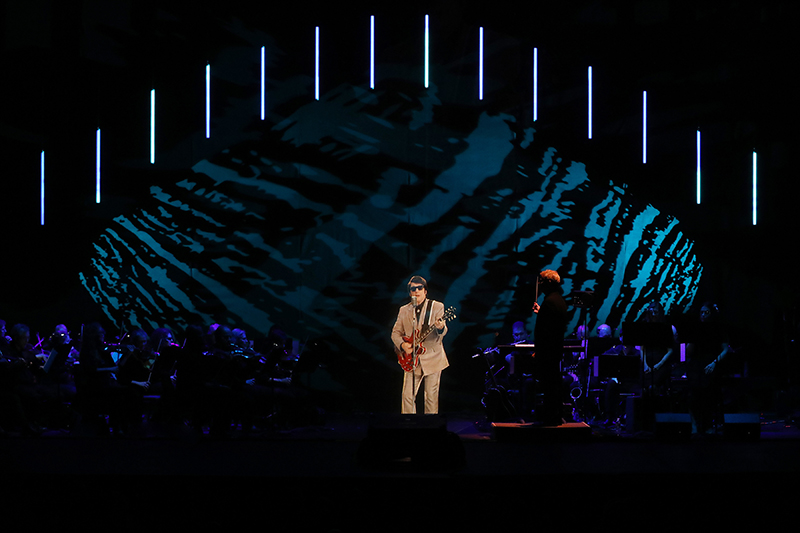
Base Hologram and Epson Turn Hologram Tour from Concept to Reality
The trite-but-true directive to “light the money” is reaching its ultimate arc with “In Dreams: Roy Orbison In Concert — the Hologram Tour.” For two dozen shows staged last fall, “The Money” was light itself — a hologram-like image brought to life on stage through the partnership of Epson and Base Hologram and their efforts to create the first one of its kind shows honoring the legendary rock ‘n’ roll crooner, who died in 1988.
“With its roots in Base Entertainment, Base Hologram formed on the aspiration to bring back the excitement and thrill of live theater for a new audience of all ages, constantly immersed in our technologically advanced world,” says Marty Tudor, executive producer and CEO of Base Hologram Productions. “We all come from the live theater business, whether it is actual theater, the rock music world or other audience-experienced entertainment.”
“In taking on this feat of bringing legends like Roy Orbison and Maria Callas to life, we required visual display technology that would allow the audience to truly feel they were experiencing these electric and spellbinding performances live,” he adds.
Tudor’s team “scoured the planet” literally until they found an alternative to the traditional Pepper’s Ghost technique which, through the use of an angled mirror and a room hidden offstage, could create semi-transparent images of actors that can instantly appear or disappear on stage “out of thin air.” The effect was popularized by John Henry Pepper in the 1860’s and is essentially how the same system used at Coachella reproduced the Tupac Shakur “hologram.”
Given the response to the Shakur image (reportedly 2 billion-plus views), Base Hologram was ready to consider holograms as a business opportunity. Realizing that one-offs weren’t financially feasible, Tudor says they “started to do our homework. We needed to find a manner of projection that would give us the brightness and intensity necessary to recreate a virtual image.”
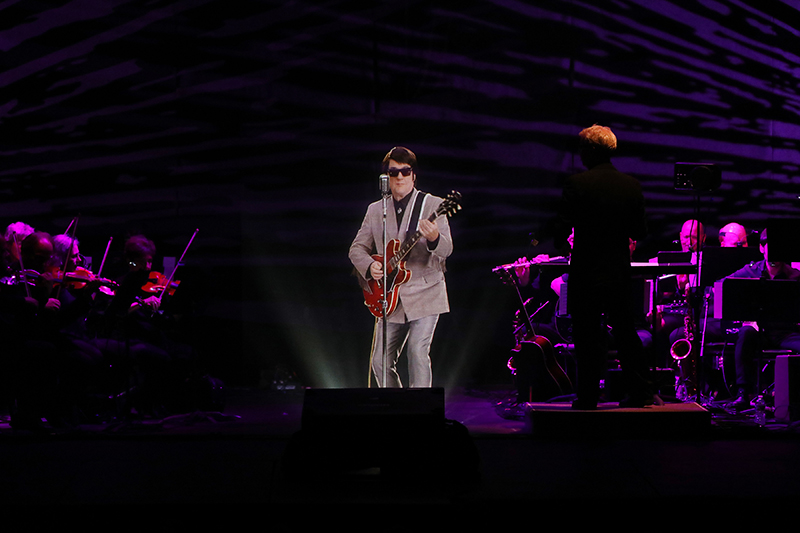
Finding Pepper’s Replacement
Seiko Epson Corp is the largest projector manufacturer in the world; a fact which has surprisingly escaped the general public’s attention. Perhaps more importantly is the additional fact the company only manufactures its chips and technology for their own products. Base Hologram was drawn to the company by word of mouth.
“Base Hologram was reaching out to creative folks that had done some earlier hologram implementations. A few were the same companies we had worked with on projects not related to holograms,” says Gavin Downey, senior product manager with Epson. The sort of collective response to Base Hologram from these other companies was “call Epson.” Tudor recalls, “Epson was making a push to get into the larger venue space at the time we connected with them. They had a solution that really met our needs and helped us accomplish what we want.”
Downey relates that, historically, Epson has worked predominantly in the home theater and educational markets. Recent years have found the company working very hard to “identify creative companies that are doing innovative and cutting- edge projects in public art, fine art, projection mapping, and live events in addition to our strong hold in education. When Base Hologram approached us about their hologram projection we were very interested.”
Epson has done a tremendous amount of engineering to achieve very high brightness while maintaining a credible color performance and image quality in their projectors. Considerable time and resources are invested into their 3LCD technology. To achieve these standards the company not only produces all their own chips, they assemble every panel in every projector in their Epson factory. These quality control standards enabled them to manufacture a very bright yet compact and quiet laser projector for use in live environment productions. Their engineers knew they were able to better control the characteristics of light over time with a laser, more so than the old style lamp based projectors.
With Base Hologram they found “a great company doing innovative work that could provide real world feedback to us,” says Downey.
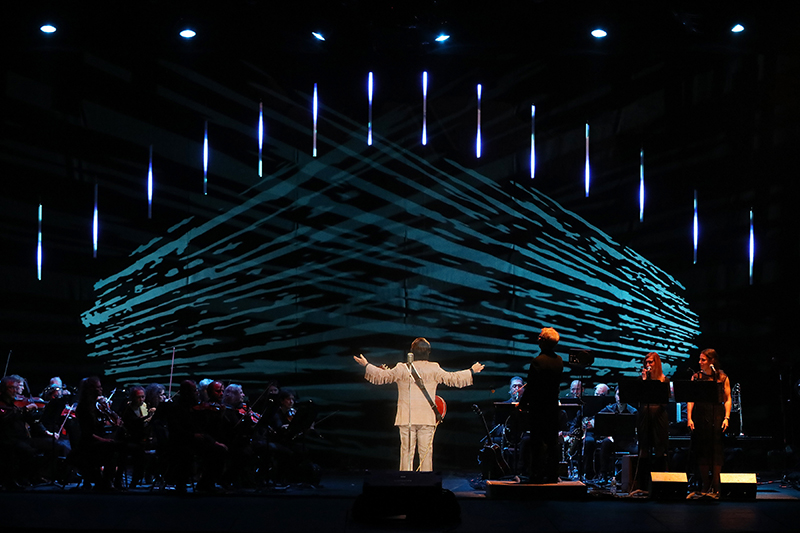
A Partnership is Formed
“This was a whole new initiative for them,” points out Downey, “and they wanted someone to talk to about equipment needs, lensing advice. Early conversations and demos were of a very exploratory nature.”
“First it was a handshake,” says Tudor, “just saying, ‘Let’s see what can be done.’ Then we formed a more defined partnership.” Tudor was as impressed with Epson’s staff as much as their technology. “They’ve been fantastic—unbelievably attentive and amazingly collaborative and supportive in helping us achieve what we needed to achieve.”
Epson not only provides gear for Base Hologram, “we also work with them,” says Downey. “It’s a virtuous circle of collaboration that often challenges us to achieve new functionality inside our projectors.”
“The ‘magic’ is what is interesting to us,” adds Downey. “That’s why we are excited about finding the people at Base Hologram who are doing such interesting visual work with a core of talented people leading the way to perfecting the process. While we are excited about the technology, we are more excited about what they are going to do with it, given they have so much experience with live events.”
The Pro L25000U projector had been launched about a year before Base Hologram approached Epson. It provides up to 25,000 lumens of color/white brightness and remarkable sharpness and color depth. This projector and others in the Pro L series have edge-blending and warping features built in, making them relatively easy to set up as required. All projectors have a camera on front, which automatically adjusts color, brightness, and helps facilitate setup.
“The built-in camera Epson uses for calibration is unbelievable. It’s very efficient, allowing us to set up in a new theater far faster than we ever thought possible,” says Michael Rahr, technical director at Base Hologram. He also credits the projectors for meeting the needs of this demanding tour. “We’re pushing these projectors to the limit, beyond their specifications, and our experience has been really good.”
Rahr, with over 25 years in the industry, brings a vast variety of visually related digital and physical based audience experience that “often involved high-profile untraditional productions that require an untraditional approach and thinking.”
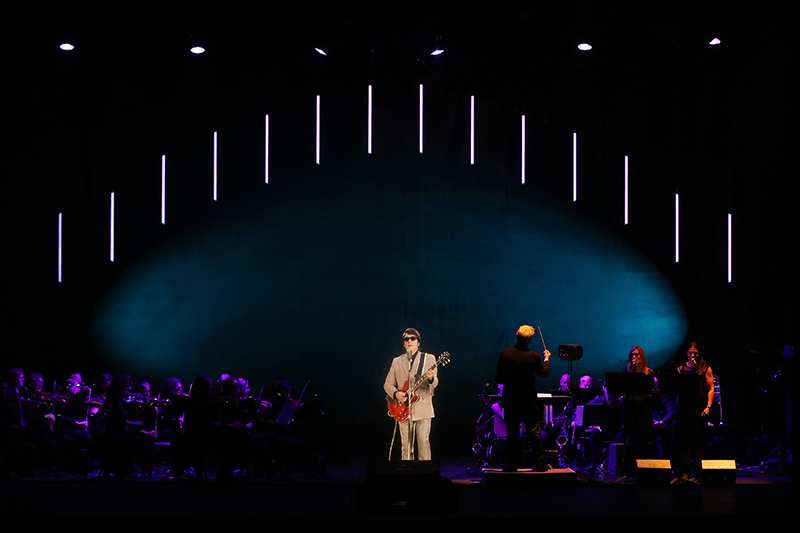
Leaving Nothing to Chance
It is a given that most live productions have redundancy backups, be it control platform wise or power. When asked how this factors into a Hologram production, Rahr responds that, “By knowing and understanding all aspects surrounding this show, including both technical and human factors, leaving nothing to chance that is under our control, can we do the risk analysis that sets the redundancy requirements needed.”
Dataton Watchout Media Servers feed content to the Epson projectors image of the hologram and timecode for audio.
“We conceived this like a Broadway show,” says Tudor. “In this case, we produced the hologram like a film and then present it like a rock show, meaning it loads in at 8 a.m. and opens at 8 p.m. that same day.” Tudor points out that there were certain physically structural requirements to mount the show. “As with most tours, we get CAD drawings of the building to see if it fits our needs. Surprisingly, a lot of buildings do not.”
Buildings were required to be re-evaluated not only from a production standpoint, but included seating and viewing evaluation as the Hologram has optimum viewing angles. Onstage placement of production support was also critical as these two particular programs (Callas and Orbison) were accompanied by full orchestras (for Orbison, a 29-piece orchestra; for Callas, a 49-piece orchestra).
An Experienced Crew
Base Hologram secured a top crew to take their innovation on the road and maintain the integrity of the concept. John “Grinda” Procaccini brings 40 years of live tour and production management to the company. In his position as vice president of touring and production for Base Hologram, he is responsible for all tour operations from conception through completion including staffing, vendor selection, building selection criteria, and budgeting, for both domestic and international tours.
“It was a unique application of all disciplines in launching these two particular Hologram tours,” says Procaccini. “We incorporated the support of live audio, lighting, video and full orchestras onstage in support of the Hologram.”
He reached out to 30-plus-year veteran Rick Fantl to handle production management duties; Jim Yakabuski to run FOH, synchronizing the Hologram track to the live orchestra conducted by Martyn Axe; and Gregg Maltby as lighting director. Kyle Bazinet serves at monitors position and also as the stage manager, and Scott Coraci handles video.
The Lighting Complement
Maltby carried a small and specifically dedicated selection of fixtures with him supplied by Morpheus Lights. Two Claypaky Scenius fixtures sit on the upstage floor throwing various breakup patterns on the upstage black drape. Their subtle presence enhanced the aesthetics of the background for the live orchestra and Orbison Hologram. An arch of 14 Astera wireless Pixel Tubes hung vertically in front of the upstage black, adding depth to the overall frame.
“The orchestra is what we light each night,” notes Maltby, who are contracted locally for each venue. “Every theater we play has a lighting system dedicated for the purpose of lighting their orchestras in one form or another. Some days we get movers, other days it is more a conventional rig.”
The conductor has a click track playing in his ear. The hologram is triggered by timecode, so he knows precisely when to start the orchestra and keep them on time.
The LD, who illuminated Huey Lewis and the News for 33 years, has also lit legendary acts Boston and Bruce Springsteen. “This is the first time in 43 years I haven’t called followspots,” smiles Maltby, who recalls Springsteen shows where he needed to call as many as 16 followspots. He carries his own Avolites Titan Tiger as a control solution, noting that “it can clone any fixture out there and can be carried on a plane.”
Up Next
Epson just launched a line of cost effective 4500 to 6000 lumen projectors with fixed lens, the PowerLite L Series, and coming soon is a 12,000 lumen Native 4K projector able to use all Epson’s existing family of lenses.
“Just recently we also provided Base Hologram a preview of a pre-production sample of our new 20,000 lumen laser projector launching mid-year 2019,” says Downey. “They were very excited about the possibilities. Really, that is our primary interest at Epson.” he adds. “Supporting people on the cutting edge, doing things that haven’t been done before with projection.”
“Epson is our projection partner, and they wanted the world to see and be aware of the things they are doing,” says Tudor. “They have been phenomenal to us as a partner,” he adds, helping with conceptual solutions along with technical issues. Among its many live productions in Las Vegas, Base Hologram is launching an Amy Winehouse tour next. “The response we have received has been phenomenal. Our opening show in London was the first time we had done this anywhere, and I was not sure just what the response would be. We knew we had the technology right, so it was a real joy to see the audience singing along and dancing in the aisles”.
For more information, visit www.epson.com and www.basehologram.com.
All images by Todd Kaplan
